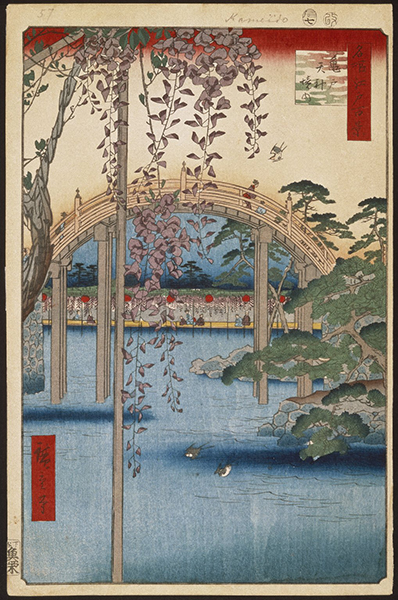Fuji (Wisteria) Matsuri: Utagawa Hiroshige
In Japan, April 21 to May 6 is the time of the Fuji Matsuri, or “Wisteria Festival.” During the festival, traditional music and dance are performed at the Kameido Tenjin shrine on the outskirts of Tokyo (traditional name Edo). Fuji is the Japanese word for “wisteria,” not to be confused with Mount Fuji, which has the same Kanji base as wisteria. In Shin Buddhism, the wisteria is a symbol of humility and reflection. It also symbolizes hardiness, as wisteria is one of the earlier of the flowering plants in spring, often blooming while there is still snow on the ground. Wisteria (fuji) is sometimes associated with immortality since it sounds similar to the Japanese word Fushi (“eternal life”). That may account for the name of the mountain, since it is considered a sacred peak where spirits of the dead can dwell.
 |
| Utagawa Hiroshige I (1797–1858, Japan), Inside the Grounds of the Kameido Tenjin Shrine, image no. 65 from One Hundred Famous Views of Edo, 1856. Color woodcut print on paper, 13 7/16" x 8 ¾" (34.1 x 22.2 cm). © 2020 Brooklyn Museum. |
Flower breeding was a popular art form in the late Edo period. This print is from Utagawa Hiroshige’s second most famous series after the Fifty-Three Stations of the Tokaido. Like many of the prints in this late series, the main subject (wisteria blossoms) is in the immediate foreground, with the human presence greatly diminished (possibly because, as a monk, he took a vow of seclusion from the everyday world). The saturated red at top and blue in the water are the result of imported Western aniline dyes. Hiroshige appreciated the brilliant colors of these synthetic dyes and incorporated them into many of his prints. The steeply arched bridge would have immediately been recognized by citizens of Edo as the Kameido Tenjin shrine, at the time on the fringe of Edo. The dedication to Tenjin—the deified Sugawara Michizane (845–903), patron saint of learning and calligraphy—is said to have been inspired by the personal veneration of the shogun Tokugawa Ietsuna (1641–80).
Hiroshige was one of the most famous Japanese landscape artists of the first half of the 1800s. Until 1830, Hiroshige produced ukiyo-e prints mostly of kabuki actors and beauties. However, the publication of Katsushika Hokusai’s (1760–1849) Thirty-Six Views of Mount Fuji between 1826 and 1833 showed Hiroshige the possibilities of landscapes. His first landscape series (late 1820s) was Famous Places in the Eastern Capital, simple popular views of spots in Edo. The series was so successful that it encouraged Hiroshige to pursue landscapes as his main subject matter.
After the famous Fifty-Three Stations of the Tokaido series (initially 1833–1834), Hiroshige undertook many other landscape series. However, the public clamored for more views of Edo. In 1856, after taking the vows to become a Buddhist monk, Hiroshige initiated a series of one hundred (actually up to 152) views of the eastern capital. Of these, 118 were published in the One Hundred Famous Views of Edo series. They were divided by the four seasons. Eighteen alternate views of the summer season were published in 1858.
Correlations to Davis programs: Experience Printmaking 1E: Chapter 4; Discovering Art History 4E: 2.3, 4.1; The Visual Experience 4E: 4.4


Comments